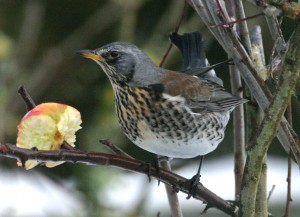 At this time of the year there are many evocative sounds in the countryside to remind us of the Autumn and the Winter ahead. One classic is the roaring of the red stags in the glens and hills, whilst another is the sound of the geese coming from their breeding grounds in the far north. Large flocks of wigeon are now in or arriving and the calls are whistle like, although that only comes from the males. If you are lucky enough to visit a grey seal colony, they are called “rookeries”, the “moaning” calls of the seals are almost eerie as if no animal could make such a sound. There are plenty of these calls but one of the more subtle ones you have to go under the hours of darkness to hear is the migration calls of the redwings. This is a soft “seeip” call mainly given in flight but the number of birds involved makes it easier to hear.
At this time of the year there are many evocative sounds in the countryside to remind us of the Autumn and the Winter ahead. One classic is the roaring of the red stags in the glens and hills, whilst another is the sound of the geese coming from their breeding grounds in the far north. Large flocks of wigeon are now in or arriving and the calls are whistle like, although that only comes from the males. If you are lucky enough to visit a grey seal colony, they are called “rookeries”, the “moaning” calls of the seals are almost eerie as if no animal could make such a sound. There are plenty of these calls but one of the more subtle ones you have to go under the hours of darkness to hear is the migration calls of the redwings. This is a soft “seeip” call mainly given in flight but the number of birds involved makes it easier to hear.
The redwings are from two main breeding areas with one in Iceland where the bulk of the Highland birds come from. What is unusual in Iceland is that there are so few trees they more often than not nest on the ground. These are often in loose colonies and the first time I saw such a colony with ground nesting birds was a surprise. Some of the redwings also come from Scandinavia from the vast forests and it is a sobering thought that when they arrive in the Highlands they may never have seen a person before! A few birds stay to breed in Scotland, mainly in the Highlands, but these days there are not more than 80 pairs. The highest numbers were in the 1980s but since then the numbers have declined although it is a mystery as to why. The birds will arrive in flocks, sometime quite large, and will immediately seek out this years bumper crop of rowan berries. Fortunately, it is a bumper crop as they have already they have been plundered by large numbers of starlings and chaffinches and family parties of mistle thrushes.
The redwings have another main competitor for any autumn food that is going as large numbers of fieldfares have also arrived although the bulk of them are still to arrive. Their breeding ground is in Scandinavia and if the food there is in good supply they may rear two broods. They too will seek out the rowan berries but they seem to be able to go onto other berries more than the redwings. They also frequent gardens and sometimes only one or two birds come in. I photographed the one feeding in the garden on an apple and it stayed for a few days before moving on. The numbers that stay to breed n Scotland are even fewer than the redwings as only about five pairs breed each year. They are larger than the redwing but, despite their size, the birds are very secretive in the breeding season so perhaps many are missed in surveys. In contrast, the winter numbers of fieldfares are staggering as in Scotland there are between 100,000 and 150,000 birds but the number on passage may be as high as 1.5 million! In the 1970s the fieldfares numbers in Europe rapidly increased and as a breeding bird they even spread to Orkney and pairs bred in northern England for the first time. However, why this potential invasion did not take place is unknown.
Tags: highland wildlife
